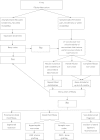Nonunion of fibula: a systematic review
- PMID: 22643795
- PMCID: PMC3427429
- DOI: 10.1007/s00264-012-1556-z
Nonunion of fibula: a systematic review
Abstract
Purpose: The purpose of this systematic review was to analyse the available evidence regarding nonunions of the fibula. We focussed on the incidence, risk factors, evaluation, and treatment modalities for fibular nonunions as evident in the current literature and propose a treatment algorithm.
Methods: This was an Institutional Review Board (IRB) exempt study performed at a level one trauma centre. We systematically reviewed the published evidence on fibular nonunion or delayed union from 1950 to February, 2011.
Results: Twelve articles were included in this systematic review. In summary, nonunion of the fibula is becoming increasingly more common in association with intramedullary nailing of concomitant tibial shaft fractures. A treatment algorithm for nonunion of the fibula has been proposed.
Conclusions: The suspicion for nonunion of the fibula should be heightened in lower leg fractures if the patient is symptomatic, and the progression of healing is not as expected. Ideally, prospective, multicentre studies would be performed to provide more rigorous data on the incidence, risk factors, and optimum treatment.
Figures






References
-
- Mendelsohn HA. Nonunion of malleolar fracture of the ankle. Clin Orthop Relat Res. 1965;11(233):103–118. - PubMed
-
- Ebraheim NA, Savolaine ER, Skie MC, et al. Fibular nonunion in combination with fractures of the tibia. J Orthop. 1993;16(11):1229–1232. - PubMed
-
- Shen WJ, Shen YS. Fibular nonunion after fixation of the tibia in lower leg fractures. Clin Orthop Rel Res. 1993;287:231–232. - PubMed
Publication types
MeSH terms
LinkOut - more resources
Full Text Sources

